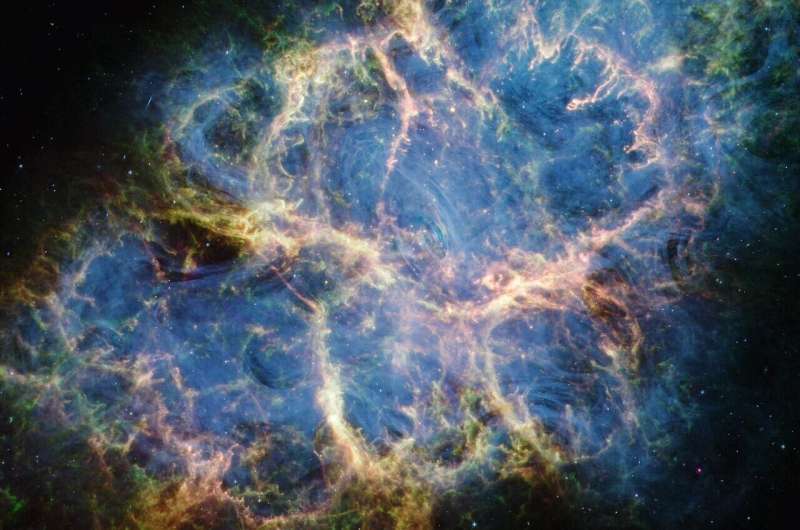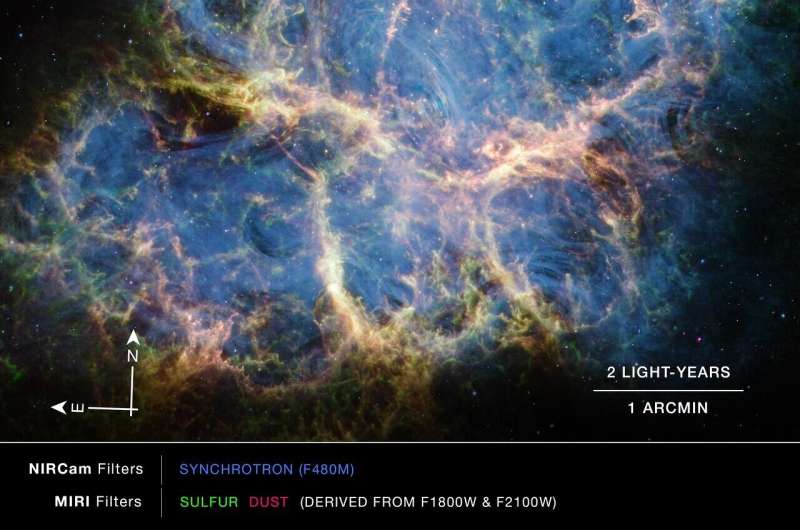
Crab Nebula (MIRI and NIRCam image). Credit: ESA/Hubble Information Center
A team of scientists used the NASA/ESA/CSA James Webb Space Telescope to analyze the composition of the Crab Nebula, a supernova remnant located 6,500 light years away in the constellation Taurus. With the telescope’s MIRI (Mid-Infared Instrument) and NIRCam (Near-Infrared Camera), the team collected data that helps clarify the history of the Crab Nebula.
The Crab Nebula is the result of a supernova core collapse that resulted in the death of a massive star. The supernova explosion itself was observed on Earth in 1054 CE and was bright enough to be seen during the day. The much fainter remnant seen today is an expanding shell of gas and dust, as well as an outgoing wind powered by a pulsar, a rapidly rotating and highly magnetized neutron star.
The Crab Nebula is also very unusual. Its atypical composition and very low explosion energy led astronomers to believe that it was an electron-capture supernova, a rare type of explosion that occurs from a star with a less evolved core composed of oxygen, neon and magnesium, rather than a star with a less evolved core composed of oxygen, neon and magnesium. more typical iron core.
Previous research efforts have calculated the total kinetic energy of the explosion based on the quantity and speed of the current ejecta. Astronomers deduced that the nature of the explosion was of relatively low energy (less than a tenth of that of a normal supernova) and that the mass of the progenitor star was between eight and 10 solar masses. , oscillating on the thin line between the stars. who suffer a violent supernova death and those who do not.
However, inconsistencies exist between the electron capture supernova theory and the Crab observations, particularly the observed rapid motion of the pulsar. In recent years, astronomers have also improved their understanding of iron core collapse supernovae and now believe that this type can also produce low-energy explosions, provided the stellar mass is low enough.
To reduce the level of uncertainty about the Crab’s progenitor star and the nature of the explosion, the science team used Webb’s spectroscopic capabilities to focus on two areas within the Crab’s internal filaments.
Theories predict that due to the different chemical composition of the core of an electron capture supernova, the abundance ratio of nickel to iron (Ni/Fe) should be much higher than the ratio measured in our sun (which contains these elements from previous generations of stars). Studies in the late 1980s and early 1990s measured the Ni/Fe ratio in crabs using optical and near-infrared data and noted a high Ni/Fe abundance ratio that appeared to favor the electron capture supernova scenario.
The Webb telescope, with its sensitive infrared capabilities, is now advancing research on the Crab Nebula. The team used MIRI’s spectroscopic capabilities to measure nickel and iron emission lines, providing a more reliable estimate of the Ni/Fe abundance ratio. They found that the ratio was still high relative to the sun, but only modestly and much lower than previous estimates.

Image of the Crab Nebula captured by Webb’s NIRCam and MIRI, with compass arrows, scale bar and color key for reference. Credit: NASA, ESA, CSA, STScI, T. Temim (Princeton University)
The revised values are consistent with electron capture, but do not rule out an iron core collapse explosion from a star of similar mass. (Higher-energy explosions from higher-mass stars should produce Ni/Fe ratios closer to solar abundances.) Additional observational and theoretical work will be needed to distinguish these two possibilities.
In addition to extracting spectral data from two small regions of the Crab Nebula’s interior to measure the abundance ratio, the telescope also observed the broader environment of the remainder to understand the details of the synchrotron emission and dust distribution.
The images and data collected by MIRI allowed the team to isolate the dust emission within the crab and map it in high resolution for the first time. By mapping the hot dust emission with Webb, and even combining it with Herschel Space Observatory data on colder dust grains, the team created a complete picture of the dust distribution: the filaments the outermost ones contain relatively warmer dust, while cooler grains predominate. near the center.
The work is published in Letters from the astrophysical journal.
More information:
Tea Temim et al, Dissecting the Crab Nebula with JWST: pulsar wind, dusty filaments and Ni/Fe abundance constraints on the explosion mechanism, Letters from the astrophysical journal (2024). DOI: 10.3847/2041-8213/ad50d1
Provided by the ESA/Hubble Information Center
Quote: Scientists study the origins of the Crab Nebula with the James Webb Space Telescope (June 17, 2024) retrieved June 18, 2024 from https://phys.org/news/2024-06-scientists-crab-nebula-james- webb.html
This document is subject to copyright. Except for fair use for private study or research purposes, no part may be reproduced without written permission. The content is provided for information only.